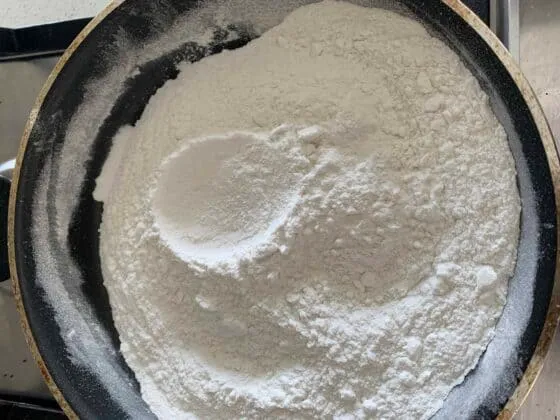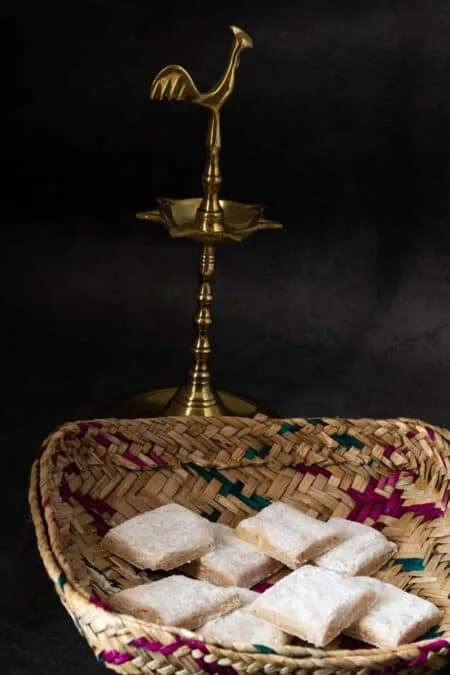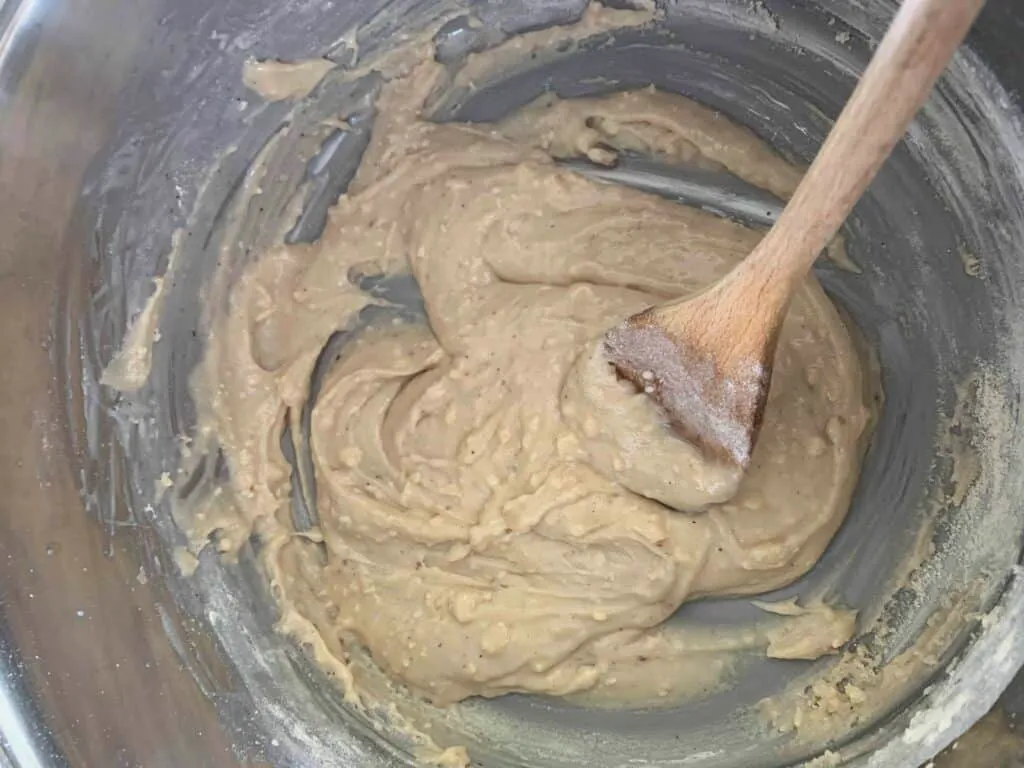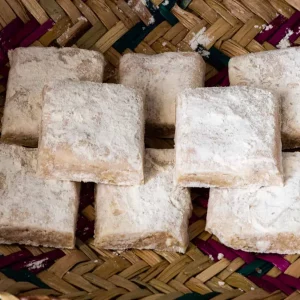Aluwa is another Sri Lankan sweet that is enjoyed during avurudu and Sri Lankan & Tamil new year. This is also called Kaju aluwa, Kiri aluwa or pani aluwa (but for pani aluwa, the sugar is replaced with treacle. However, it is called, Aluwa which is white in colour and so delicious and easy to make than any other traditional Sri Lankan sweets.

Making aluwa is quite similar to making milk toffee, both require the mixture to come to the correct consistency before shaping it. So the hardest part of making aluwa is actually getting the mixture to the correct consistency.
Now in Sri Lanka, Aluwa is made very thick. I actually don’t like it being too thick, because this will affect the texture of the aluwa. I like it is medium size, so it’s easy to eat and the flavour is much better as well.
I have never made aluwa before COVID happen in 2020. We were all in lock down during the avurudu period. Since we had nothing to do, I decided to try my hand at making some kavili that I have never attempted before. I used a basic recipe from the internet and I tweaked it until I was happy with the flavour and texture. I didnt actually use one recipe, I looked at many recipies and took the concept of aluwa and added my own touch to it.

Soon after making my aluwa recipe, everyone said that this was the best aluwa recipe they have tried, so I am actually going to hang on to that title, and I am about to share that recipe with you all. Now I am not going to lie, I had to make this recipe close to 10 times, to understand what can go wrong and to perfect this recipe, so it’s safe to say my husband is a supertaster of aluwa now hhahahhahah
Troubleshooting common mistakes made when making aluwa
Roasting Rice flour
Rice flour needs to be roasted. I use ready-made rice flour. There are some rice flour that is titled on the packet saying roasted rice flour here in Australia, I haven’t tried them, I have only tried the Derana white rice flour, so if you can use that, please use it. some times, the results will be different when using different brands of rice flour.
Roasting the rice flour correctly is important. Firstly when roasting, it will take off the moisture in the flour also be careful not to roast it too much which will affect the overall colour of the product. Just roast it until it is slightly off white colour.

Making the sugar syrup
Making the sugar syrup with coconut milk and sugar is very crucial, this will determine if the aluwa sets properly or if it will be like rocks.
The sugar consistency has to be like syrup, when you pour the syrup down with a spoon, the last drop must hang on the spoon and stretch for about 1 cm. You can also see with your eyes, the sugar syrup has become a creamy white syrup as opposed to a see-through syrup when you first started.
What do I do if I add the flour too early before the sugar syrup comes to its correct consistency?
Aluwa is quite forgiving when compared to most other kavili. So if you get the consistency wrong and mix the flour before the syrup has come to its proper consistency, it will be hard to slice because it will be stretchy and sticky, but once you keep it for 3 days, it will harden up a bit and it will still be edible and tasty but with a softer texture.
What do I do if I add the flour too late after the sugar syrup has become too syrupy?
So in this case you have two options, either don’t add a lot of flour. If not if you have mistakenly added a lot of flour, you can still save it, but you have to work quickly. It will set very quickly, the texture will not be smooth, but it won’t be bad that you have to throw it away, you can still eat it, but the texture in the mouth will be grainy.
What’s the correct consistency of the aluwa
It is soft to bite, when you eat it, it will break easily and doesn’t require much effort to bite into it.

How to store Aluwa
Aluwa has to be stored in an airtight container in a cool and dry place.
How to slice Aluwa
You have to cut it quickly, once the aluwa is moulded, so work quickly at that point. I cut it in squares because it’s easier for me, you can also cut it in diamond shapes. It is whatever is easier for you. Use a clean knife, you will have to scrape the parts that are stuck to the knife with a dough scraper or fork before cutting it.
How long in advance to make aluwa
Aluwa can be made a week in advance. If it’s your first time, make it in advance, so even if you get the consistency wrong you can either remake it or you can leave it to harden up.
What flour to use for aluwa
I use ready-made rice flour. Use very fine rice flour. I have used quite a few different brands of ready-made rice flour here in Melbourne. Not every rice flour will give the best results, so I recommend using Derana white rice flour. If you guys want to make the rice flour from scratch you are more than welcome to do it, but ready-made rice flour works well too.
How to make coconut milk with coconut milk powder
When making aluwa it is important to use thick coconut milk, this will give you a creamy taste. use 40g Coconut milk powder with 150g water. Coconut milk powder doesn’t dissolve very well with cold water, so first add about 50g hot water just to dissolve the coconut milk then top the rest with cold water.
What type of pan to use for Aluwa
I suggest using an oval Thachchi (pan) you can buy this in any Sri Lankan supermarket, but a medium-size one, a little bigger than a hopper pan. Don’t use a non-stick one, a aluminium one is best for this purpose.
You can also check my other Sri Lankan Avurudu sweets
Watch how to make aluwa recipe
Step by Step recipe on how to make aluwa recipe
Aluwa recipe
Equipment
- Oval pan
Ingredients
- 175 g White sugar
- 150 g Thick coconut milk (40g coconut milk powder+150g water)
- 200 g White rice flour ( reserve 50 for dusting)
- 10 numbers Cashews ( roasted)
- 8-10 pods Cardamom pods
- 1 Tbsp Sesame seeds
Instructions
Step 1 ( Cardomom pods)
- In a mortar pestle, crush the cardamom pods slightly, take off the outer shell and put the seeds inside back into the mortar pestle and grind until crushed well like a powder
- Mix 10g sugar from the sugar quantity mentioned in the recipe and mix together. keep the mix aside
Step 2 ( Cashews)
- Into the same mortar pestle adds the cashew nuts and crush them until it breaks down into little pieces. (if you wish you can also chop the cashews up with a knife as well)
Step 3 (Roasting Rice flour)
- In a medium metal oval wok ( thachchiya) roast the rice flour for about 8-10 minutes in a low to medium fire. Take it off the fire when done. Be very careful when roasting the rice flour, you don't want to burn it but slightly roast it. once roasted, sieve the roasted rice flour
- From the roasted rice flour mixture weigh 50g rice flour onto another bowl and leave aside (This is to dust on the aluwa)
Step 4 ( Making the Aluwa)
- Into the same pan add coconut milk and sugar and leave it on a medium fire for about 6-8 minutes. Make sure the mixture turns into syrup. Check the article above for the correct consistency. If this step is not done properly this will affect the overall dish. Check the article above on how to do it properly.
- When the mixture is halfway done, add the cardamom and sugar mixture and the sesame seeds. Once the syrup reached the correct consistency turn off the fire add the rice flour in batches slowly. once one part is added, stir it well until incorporated, when fully mixed then add the other part. depending on the rice flour brand used and the thickness of the syrup, the flour needed will be dependant. The texture of the mix should be thick and you will feel, the mixture is about to set. Although the recipe calls for a specific quantity of flour, you might need less or more, if you need more use it from the reserved roasted rice flour that was kept aside. But if you do this correctly and use the same brand of rice flour as I have used, then you will only need the quantity specified in the recipe.
Step 5 ( Shaping and cutting the aluwa)
- Dust a good amount of rice flour that was kept aside onto a chopping board ( you can do this step, while the syrup is on the fire)
- Pour the aluwa mixture on to the chopping board, shape it into a square shape using a spatula or a dough scraper (Apply coconut oil to the spatula or dough scraper so the mixture doesn't stick)
- Dust some of the reserved roasted rice flour on top of the aluwa, quickly cut the sides and cut into square equal pieces using a knifeYou will need to scrape the parts that are stuck on the knife using a dough scraper(If by any chance you had to use the reserved rice flour that was kept for dusting, then just use unroasted rice flour straight from the packet)
- Once cut dust the reserved roasted rice flour onto all the sides of the square pieces.
- Leave to cool down completely and store it until needed



